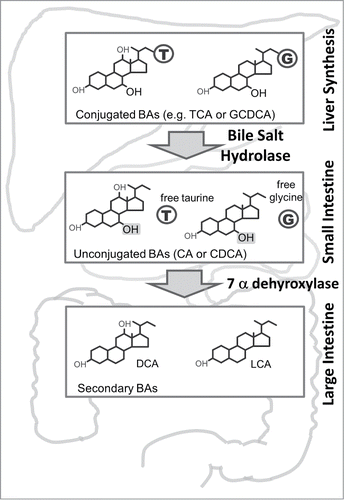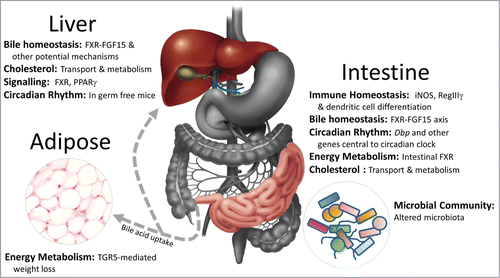Figures & data
Figure 1. Microbial Metabolism of Bile Acids. Bile acids are synthesized from cholesterol in the liver as moieties that are conjugated either to a glycine (G) or taurine (T) molecule. They are stored in the gallbladder and subsequently released into the duodenum. In the small intestine microbial BSH activity removes the glycine or taurine molecules to produce unconjugated bile acids (BAs). Bile acids are efficiently reabsorbed via the terminal ileum into the enterohepatic portal system but some enter the large intestine where they are further metabolised by microbial 7a dehydroxylase enymes to produce secondary BAs. CA, cholic acid; CDCA, chenodeoxycholic acid; TCA, taurocholic acid; GCDCA, glycochenodeoxycholic acid; DCA, deoxycholic acid; LCA, lithocholic acid. T, taurine; G, glycine, represent free amino acids liberated through BSH activity.

Figure 2. Impact of unconjugated bile acids upon local and systemic physiological processes in the host. Some of the key findings linking predominately unconjugated bile acids with intestinal and systemic responses in the host. In addition to a role in the emulsification of dietary fats in the gut, bile acids affect immune homeostasis, energy metabolism, bile acid homeostasis and potentially peripheral circadian rhythm. Importantly unconjugated bile acids also have a significant impact upon the makeup of the gut microbial community which may have further implications for the host. iNOS,Citation34 RegIIIγ,Citation20 dendritic cell differentiation,Citation35 FXR-FGF15 axis,Citation43 circadian rhythm,Citation20 intestinal FXR,Citation45 cholesterol metabolism,Citation30 microbial community structure,Citation32,33 liver FXR signaling,Citation18,27,29 PPARγ liver,Citation20 energy metabolism in adipose tissue.Citation19

